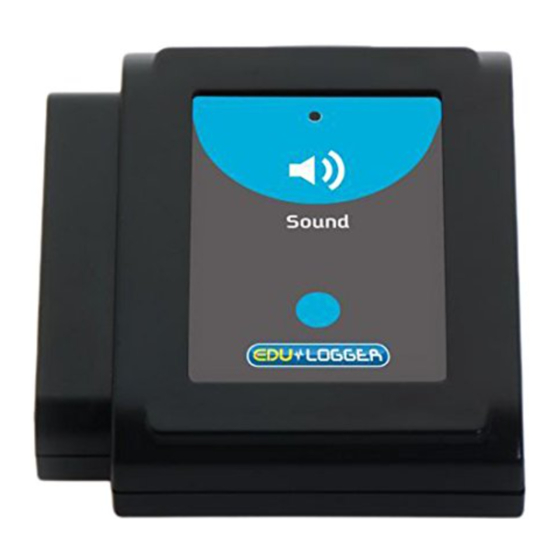
Advertisement
Quick Links
Advertisement

Summary of Contents for Edu-Logger 900-212
- Page 1 Edu-Logger Sound Logger Sensor Guide 900-212...
- Page 2 The sensor comes pre-calibrated so you can start experimentation right out of the box using this guide. Hundreds of possible experimental subjects that can be done with the 900-212 sensors are: wave theory, sound pressure, sounds intensity, sound theory (pitches, frequencies, etc), wave interference, and many more.
- Page 3 Quick start procedure: PC or Mac Computer Materials needed: 900-212 Sound Sensor 900-213 USB Module USB to mini USB cable (included with the 900- 213 module) Your sound sensor needs to be connected to a 900-213 module.
- Page 4 Your sound sensor needs to be connected to a 900-268 module. The 900-268 module will create a closed Edu-Logger WiFi network which will stream the Edu- Logger data to a device of your choosing. Once your device is wirelessly connected to the Edu-Logger network you can run experiments and collect data through a browser of your choosing.
- Page 5 LED to the far left turns blue; this can take up to one minute. Take your tablet or smart phone, go to the WiFi settings and select the Edu-Logger network which matches the 900-268 Module ID found on back 900-268 device.
- Page 6 Repeating this operation will return the unit to WiFi mode. Operation with Edu-Logger viewer Materials needed: 900-212 Sound Sensor 900-272 Viewing Module 900-215 Battery Procedure: Connect the sound sensor to the left side of the viewer.
- Page 7 (Off-line experiments are for when you do not have a sensor connected directly to a computer, tablet, smartphone, or Edu-Logger viewer). Materials needed: 900-212 Sound Sensor 900-215 Battery Materials needed to configure your offline experiment: 900-213 Module or 900-268 module or 900-272 Module ...
- Page 8 Click the “Load data from sensors” button. Select which experimental data to upload. (5 experimental runs can be stored at one time on the 900-212 sound sensor) Restoring sensor’s factory default settings: Procedure: Connect the 900-213 to a PC, Mac, tablet, or smart device.
- Page 9 Included with sensor: Edu-Logger 900-212 Sound Sensor Guide (this document). Sensor specifications Sound level Sound signal (dB) Arbitrary Range and 40 to 110 0-4095 operation modes 12 bit ADC resolution ± 2 Accuracy Resolution Max sample rate 10,000 (S/sec) Sensor features: ...
- Page 10 Videos, literature and other probes can be found at www.edulab.com Technical background: The philosophy behind Edu-Logger’s plug and play technology is based on each sensor’s ability to store its own data due to an internal flash memory chip and micro-controller in each plastic Edu-Logger body.
-
Page 11: Warranty
This design of the sensor enables to use this sensor as two sensors: microphone and sound level sensor. Maintenance and storage: Never submerge the Edu-Logger plastic body in any liquid. Do not allow liquid into the sound sensor’s body. - Page 12 Thank you for using Edu-Logger! Flexible, simple, fast, forward thinking. www.edulab.com info@Edulab.com V10012013...












Need help?
Do you have a question about the 900-212 and is the answer not in the manual?
Questions and answers